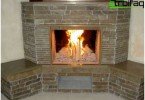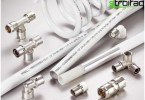Private house heating
A high level of coziness and comfort in a country house in the cold season can be achieved due to the presence of a high-quality heating system in it. Fireplaces that allow heating the space around them are especially popular today. But their presence allows you to live in a country house only in the warm season, and with the onset of cold weather you have to return to the city apartment. Many owners of country houses refuse the heating system because of the high cost of work, but anyone who knows how to handle the tool can make heating a private house with their own hands.
Content
- Water heating system
- Material for laying the pipeline
- Two circuits or one?
- Preferred Wiring Type
To create heating for a private house, you will have to develop a design scheme for the heating system. To do this, you should immediately determine which heating system will be installed in the house: water, steam, air or electric. At the stage of project development, it is necessary to calculate the required system capacity. You will also need a drawn diagram of the heating of a private house indicating all elements of the system.
The heating system of a private house largely depends on the preferences, financial capabilities of the owners and the advisability of its installation in the house. Among the existing types of heating systems should highlight water, steam and electric. Each of these systems has its advantages and disadvantages. To create a fully autonomous heating of a private house – water, steam or electric, you will need materials and heating devices for each type of heating separately, as well as a specialized storage for fuel.
Water heating system
This heating system is the most common. Water heating in a private house by its operational qualities is the most reliable and simple. The main elements of a water heating system are a boiler, expansion tank, pipe network, radiators. As an additional equipment for this system, a circulation pump, a temperature regulator, safety valves and an air vent are used..
Almost any fuel can be used for such a heating system, the main thing is that the boiler runs on this fuel. For a water heating system, steel pipes, galvanized, stainless steel, copper or polymer pipes are usually used. The reliability and durability of the system itself will depend on the selected material for pipes..
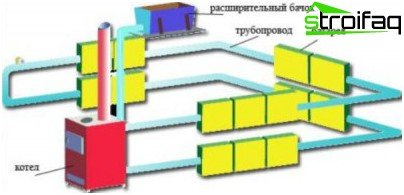
Private house water heating
Material for laying the pipeline
- Steel is subject to severe corrosion, but it is cheap and affordable. Installation of steel pipes is carried out by welding. Galvanized steel pipes are recommended to be threaded. Of course, you can go through welding, but then the junction will rust.
- Stainless steel pipes are one of the most durable, but their cost is high. Connecting stainless steel pipes can be threaded.
- Copper pipes are among the most durable, reliable and expensive. To connect them, use soldering with silver-containing solder.
- Polymer pipes are cheap and affordable. They can be connected using stamped threaded connections or by soldering. The disadvantage of polymer pipes is their poor resistance to temperature extremes.
Two circuits or one?
Water heating in a private house can be done single-circuit and double-circuit. Their main difference is that the dual-circuit system is used for space heating and domestic water heating, and the single-circuit system is used only for one of these purposes. Quite often, two single-circuit systems are laid in the house: one for heating, the other for heating water. This is done with the aim of heating water for domestic use in the warm season. With this approach, it should be taken into account that heating water for domestic use uses only 25% of the boiler capacity.
Preferred Wiring Type
Pipe wiring in a private house can be performed in various ways: one-pipe, two-pipe, collector. In private homes, it is recommended to do two-pipe wiring, as it allows better temperature control and easier operation.
Important! Radiators are installed under the windows of the house. Their dimensions should completely cover the window opening, so if you could not install one large radiator, you can put two radiators of standard sizes.
Calculation of heating a private house for a water system is as follows. First, we summarize the number of all radiators that will be installed. Then we multiply their number by their power and get the necessary power for the boiler. Based on these data, select a boiler.

Table of required boiler power
Important! For the convenience of choosing the boiler of the required power, you can use the above table. It indicates the standard requirements for boiler power depending on the area of the house.
Steam Heating: Pros and Cons
This heating system in private homes is rarely used. But steam heating in a private house has a number of significant advantages.
- Firstly, there is practically no heat loss in radiators.
- Secondly, steam has heat storage properties, which allows the use of pipes of smaller diameter.
- Thirdly, the entire steam system warms up faster due to its low inertia.
Unfortunately, there are two significant drawbacks to this system. The first is a short service life, and the second is a very high temperature, you can get a burn from touching a radiator or pipe.
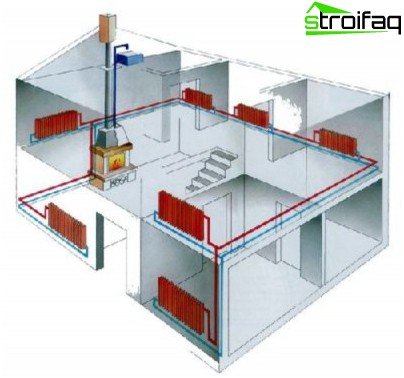
Steam heating of a private house is characterized by rapid heating and minor heat loss
As for the water heating system, one-pipe and two-pipe heating systems are used.
Depending on the vapor pressure of the system, there may be low pressure and high pressure. By type they are closed and open, the difference in the method of condensate return.
Installation of water and steam heating systems
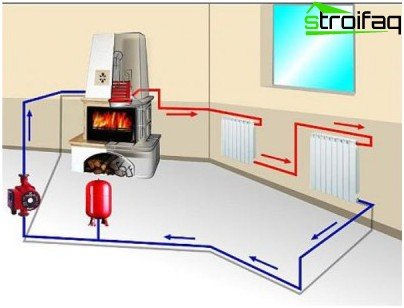
Scheme of single-circuit water heating of a private house with a pump and an expansion tank
If from the very beginning the heating in the house was planned to be done from a stove or fireplace, then at the stage of their construction one should install either a chimney with a built-in coil or a water-heating casing. Already to these built-in elements will be connected to the heating system. A stove or fireplace can be left for safety and a gas or electric boiler can be installed in parallel. For the boiler itself, it is necessary to prepare a room – a boiler room. Lay refractory material at the installation site, as well as wall them around the boiler.
Important! The boiler is placed at some distance from the walls, this provides access to it if necessary. To remove the combustion products of the boiler, it is necessary to make a chimney nearby and bring it to the street.
The scheme of the heating system of a private house clearly shows the location of the necessary nodes.
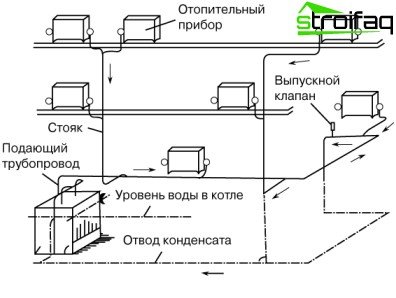
Steam heating system diagram
Near the boiler, it is possible to install circulation pumps and distribution manifolds, an expansion tank, measuring and regulating devices, shutoff valves. All pipe lines for the heating system will diverge from the boiler room. If the boiler room was designed in advance, then all openings for pipes will be prepared. In the case when the heating system is laid in a long-built house, you will have to use a puncher and punch holes for pipes, and after laying them, carefully cover them with cement mortar. Pipes are mounted in designated areas and attached to the walls. The pipe system includes risers and connections to radiators. The method of connecting pipes is selected depending on the material.
Important! To seal the threaded connections, use a tow and a special sealant. Steel and galvanized pipes must be painted. So they will last longer.
At the final stage, the installation of radiators. They are placed on brackets screwed or walled into the wall. There are two types of radiators on the market today: reinforced and standard. Reinforced radiators are designed for a system pressure of 16 bar, standard – for a pressure of 6 bar. When choosing, consider this characteristic. To achieve the best heat transfer, the radiator must be installed so that the distance from the floor to the radiator is 10-12 cm, from the wall 2-5 cm, from the window sill to the radiator 10 cm. Shut-off and control valves should be installed at the inlet and outlet of the radiator. Thanks to it, you can adjust the temperature, shut off the water or steam for repair or replacement..
Electric heating: calculations, installation
Heating a private house with electricity has gained popularity with the advent of modern convectors. These devices are installed around the perimeter of the room and under the windows. Electric heating of a private house has the following advantages: ease of installation and maintenance, efficiency. Among the shortcomings, it should be noted the dependence on the supply of electricity, if there are interruptions in the supply, you will have to put the generator on fuel. A significant drawback is the overdrying of indoor air.
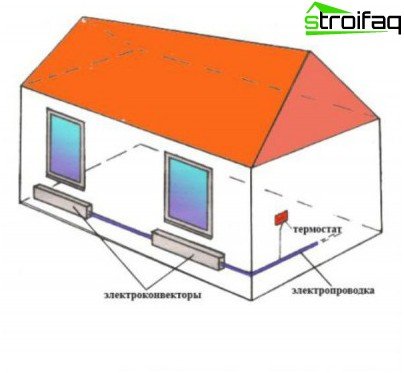
An electric heating system cannot be called the cheapest because of the cost of energy, but making it yourself is the easiest
The electric heating circuit includes convectors, electrical wiring and a thermostat. Installing such a system will require minimal effort. It is enough to lay the wiring and install the convectors on the wall or floor.
The calculation for such a system is as follows. The required power for heating 1 m3 of the room is taken as a basis. So for a perfectly insulated room you need 20 W / m3, for rooms with insulation of floors and walls you need 30 W / m3, for poorly insulated 50 W / m3. The required power is multiplied by the volume of the room and divided by the power of one convector.
The heating device in a private house of one kind or another depends on the availability of energy resources. If a gas main is brought to the house, then it will be wiser to use it. In places where there is no gas, you can install electric heating. If there is a power outage, you can use a different type of energy, the main thing is that it is affordable.




